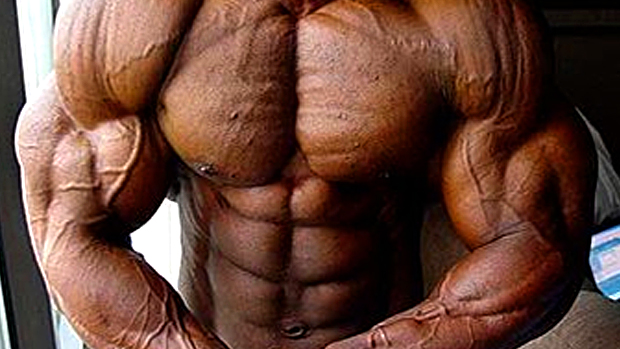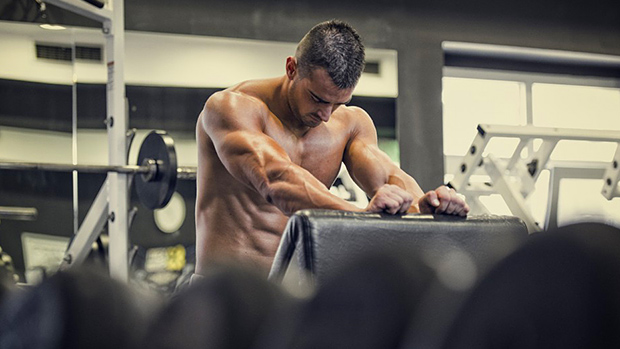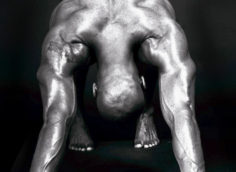Of the Five
Battle-Tested Strategies for Size and Strength, I've gotten the most
feedback on the Shotgun Method. Part of its appeal is its flexibility.
The Shotgun Method allows you to accomplish two goals with one shot:
muscle bulk and symmetry.
The concept of muscle bulk is where one gains as much muscle as possible
throughout the body, regardless of how the physique looks overall. With
muscle bulk, mass and size are king.
Muscle symmetry, however, is where one develops muscles in certain proportions
to each other to create an aesthetically pleasing physique. With muscle
symmetry, the classic V-taper wears the crown.
The advantage of the Shotgun Method is that you can train for both size
and symmetry without having to skimp on either. It allows you to fully
concentrate on the big lifts without neglecting isolation exercises that
address lagging body parts. In fact, the heavy lifting primes your body's
biochemistry and nervous system for hypertrophy. Intrigued yet?
Although a lot of interest has been generated about the Shotgun Method,
I've also been fielding a full clip of questions about how to create
a program based on it.
How to Select Shotgun Movements
To review, the Shotgun Method involves choosing the fewest number of
exercises to stimulate the most amount of muscle. Typically, what's chosen
are the power lifts (bench press, squat, and deadlift) and the Olympic
lifts. But for a complete full body workout, you should include these
three categories:
1. Leg movement (squat and deadlift variations)
2. Pulling movement (pull-up and row variations)
3. Pressing movement (bench press and overhead press variations)
Once you've chosen three shotgun exercises, you'll blast away at them
with multiple sets (6 to 8 sets per exercise) of a heavy weight (3 to
6 reps). This set and rep scheme on the big lifts will build a lot of
muscle that can be refined through "troubleshooting movements."
How to Select Troubleshooting Movements
Now, set your sights on troubleshooting movements to address any body
parts lagging in size or strength. If you're an athlete, your troubleshooting
movements may address issues such as:
• Shoulder stability (rear laterals, rotator cuff
exercises, face pulls, wall slides, etc.)
• Abdominal strength (planks, ab wheel, etc.)
• Active recovery (push-ups, sled drags, halos,
etc.)
• Any strength imbalances particular to your
sport that aren't addressed by your shotgun movements.
If you're a bodybuilder, however, and are more interested in symmetry,
then a typical approach to troubleshooting is to develop muscles that
are "pivot points."

The term "pivot point" was coined by Lou Degni and brought to public
attention by Larry Scott. The concept involves developing muscles located
in strategic parts of the body to create an aesthetically pleasing and
muscular physique, stressing a V-taper. The major pivot points you want
to target are:
• Calves
• Lateral deltoid
• Triceps (long head)
• Brachialis
• Posterior deltoid
• Upper chest
• Vastus medialis
• Teres major and Latissimus dorsi
• Forearms
Of the nine pivot points, the first five should be emphasized in your
troubleshooting workouts, since carefully chosen shotgun movements will
take care of the last four.
Split Routine for the Shotgun Method
A split routine for the Shotgun Method consists of four workouts per
week: two shotgun workouts and two troubleshooting workouts.
|
Day 1 |
Shotgun workout |
|
Day 2 |
Troubleshooting |
|
Day 3 |
Off |
|
Day 4 |
Shotgun workout |
|
Day 5 |
Troubleshooting |
|
Day 6 |
Off |
|
Day 7 |
Off |
As you can see, troubleshooting workouts are always scheduled after shotgun
workouts to take advantage of the Testosterone pulses and nervous system
stimulation generated from the heavy compound movements.
Here's the Shotgun Method in detail:
Day 1: Shotgun
A1) Pull-up
Sets: 8
Reps: 4 to 6
Rest: 100 seconds
A2) Standing military press
Sets: 8
Reps: 4 to 6
Rest: 100 seconds
B) Deadlift
Sets: 8
Reps: 4 to 6
Rest: 120 seconds
Day 2: Troubleshooting
A) Standing dumbbell lateral raise
Sets: 5
Reps: 10 to 12
Rest: 60 seconds
B1) Zottman curl
Sets: 5
Reps: 5 to 7
Rest: 100 seconds

B2) Decline dumbbell extension
Sets: 5
Reps: 5 to 7
Rest: 100 seconds
C) Seated calf raise
Sets: 5
Reps: 10 to 12
Rest: 60 seconds
Day 4: Shotgun
A) Bench press
Sets: 6
Reps: 4 to 6
Rest: 120 seconds
B) Seated cable row
Sets: 6
Reps: 4 to 6
Rest: 120 seconds
C) Squat
Sets: 6
Reps: 4 to 6
Rest: 120 seconds
Day 5: Troubleshooting
A) Standing machine calf raise
Sets: 5
Reps: 10 to 12
Rest: 60 seconds
B1) Spider curl
Sets: 5
Reps: 5 to 7
Rest: 100 seconds

You can perform spider curls by flipping
the preacher curl pad around.
B2) Lying triceps extension
Sets: 5
Reps: 5 to 7
Rest: 100 seconds
C) Rear lateral raise
Sets: 5
Reps: 5 to 7
Rest: 90 seconds
Start Blasting!
Now you don't have to sacrifice size for symmetry or symmetry for size.
With the Shotgun Method, you can train for both. Train smart and stay
safe (don't blow a hole through your high-tops).






